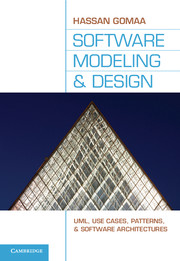Book contents
- Frontmatter
- Contents
- Preface
- Annotated Table of Contents
- Acknowledgments
- PART I Overview
- 1 Introduction
- 2 Overview of the UML Notation
- 3 Software Life Cycle Models and Processes
- 4 Software Design and Architecture Concepts
- 5 Overview of Software Modeling and Design Method
- PART II Software Modeling
- PART III Architectural Design
- PART IV Case Studies
- Appendix A Catalog of Software Architectural Patterns
- Appendix B Teaching Considerations
- Glossary
- Answers to Exercises
- Bibliography
- Index
3 - Software Life Cycle Models and Processes
from PART I - Overview
Published online by Cambridge University Press: 05 June 2012
- Frontmatter
- Contents
- Preface
- Annotated Table of Contents
- Acknowledgments
- PART I Overview
- 1 Introduction
- 2 Overview of the UML Notation
- 3 Software Life Cycle Models and Processes
- 4 Software Design and Architecture Concepts
- 5 Overview of Software Modeling and Design Method
- PART II Software Modeling
- PART III Architectural Design
- PART IV Case Studies
- Appendix A Catalog of Software Architectural Patterns
- Appendix B Teaching Considerations
- Glossary
- Answers to Exercises
- Bibliography
- Index
Summary
A software life cycle is a phased approach to developing software, with specific deliverables and milestones within each phase. A software life cycle model is an abstraction of the software development process, which is convenient to use for planning purposes. This chapter takes a software life cycle perspective on software development. Different software life cycle models (also referred to as software process models), including the spiral model and the Unified Software Development Process, are briefly described and compared. The roles of design verification and validation and of software testing are discussed.
SOFTWARE LIFE CYCLE MODELS
The waterfall model was the earliest software life cycle model to be widely used. This section starts with an overview of the waterfall model. It then outlines alternative software life cycle models that have since been developed to overcome some of the limitations of the waterfall model. These are the throwaway prototyping life cycle model, the incremental development life cycle model (also referred to as evolutionary prototyping), the spiral model, and the Unified Software Development Process.
Waterfall Life Cycle Model
Since the 1960s, the cost of developing software has grown steadily and the cost of developing and purchasing hardware has rapidly decreased. Furthermore, software now typically costs eighty percent of a total project's budget, whereas in the early days of software development, the hardware was by far the largest project cost (Boehm 2006).
Information
- Type
- Chapter
- Information
- Software Modeling and DesignUML, Use Cases, Patterns, and Software Architectures, pp. 29 - 44Publisher: Cambridge University PressPrint publication year: 2011
